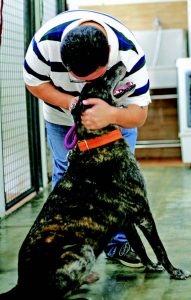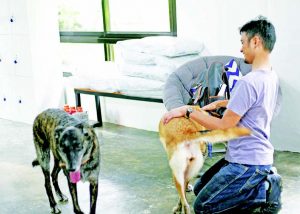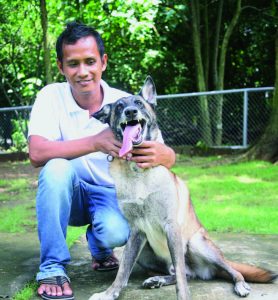“When military dogs find themselves discarded after retirement, this place gives them the life they deserve.”
In a secluded part of Angat, Bulacan, 1,200-square-meter facility serves as a retirement home for eight former military working dogs (MWDs). Called Hound Haven, this facility houses several four-legged heroes who devoted most of their lives serving with the police and military.

A canine’s average lifespan is around 10 to 13 years and in the case of MWDs, much of it is spent protecting human lives. Sadly, a majority of these dogs end up in cages for the rest of their lives after they are deemed no longer fit to serve.
“They usually work until they’re eight to 15 years old. [Once they retire, they are offered for adoption to their handlers. If the handler says no, they end up in the] kennel,” said Jerome Arcebal, Hound Haven’s corporate secretary.
Family Matter

As self-professed dog lovers, Arcebal’s family decided to start a sanctuary that caters to retired MWDs. Still run by family and friends, his sister, Rachelle, nieces Maxin Arcebal and Chelsea Pecson, and friend Addi dela Cruz are co-founders of Hound Haven.

“When we started doing ground work, we saw that retired working dogs were in need of attention,” Arcebal said. “We wanted to give them a good retirement [after we found out that the US had laws to protect them but the Philippines had none, and that we still need] to consolidate efforts.”

Pro-canine Policy

Hound Haven is the first and only organization in the Philippines that provides a retirement program for retired K-9s. Apart from providing these dogs a second chance to live a normal and happy life, the crew wants to lobby a policy that specifies a retirement age for these canine heroes, akin to Robby’s Law in the US (H.R. 5314).
Persons, not Property

For many countries, animals — even companion animals like dogs — were considered property. While movements around the world are pushing to have the “personhood” of animals recognized by the government, much has to be done before real progress is made.
Sadly, this means that even the process of turning over MWDs to the Hound Haven can be rather grueling.

Because military dogs are considered “equipment,” the Commission on Audit needs to approve their removal from the roster and, in effect, cancel the budget allotment. Only after this is accomplished can the dogs be retired from service and transferred to the sanctuary.
“For an MWD to be turned over to Hound Haven, the kennel master, evaluator, and veterinarian must first do a medical evaluation. The form is then signed by the unit veterinarian,” said Maj. Lawrence San Juan, Philippine Army K-9 Batallion’s commanding officer.
Robby’s Law

According to the Justice of TEDD Handlers website, “Robby’s Law was signed by President Bill Clinton in November 2000 and required all military working dogs suitable for adoption be available for placement after service.” Before the law was passed, 1,600 dogs used in the Vietnam War were euthanized at the end of their service.
Once a Hero, Forever a Hero
Washington Post journalist Elizabeth Svoboda once wrote in a 2013 article that heroes were made, not born. “Actions like these might seem to be split-second snap judgments, but often they are a natural result of lives that have primed people for selflessness.”

K-9s start training with the military as early as eight weeks old to strengthen their natural instincts and hone their skills. One finds them front and center with soldiers during war.
“In every operation, we are always with them – our MWDs are the essence of the unit’s existence,” said San Juan. “Without them, we are nothing. They are heroes just as much as any other member of the team.”

After a lifetime of intensive training and war-related stress, these dogs need more than just medals for their service; they also deserve a good life. And after they die, they deserve a hero’s burial, just like any soldier who gave their life for freedom.”
This appeared in Animal Scene magazine’s September 2018 issue.






